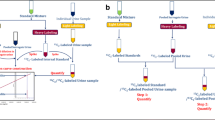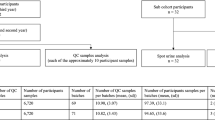Abstract
We have developed and validated a high-performance liquid chromatography-tandem mass spectrometric (LC-MS/MS) method for determining urine caffeine and 14 caffeine metabolites suitable for estimating caffeine exposure and metabolic phenotyping in population studies. Sample preparation consisted solely of a series of simple reagent treatments at room temperature. Stable isotope-labeled analogs were used as internal standards for all analytes. We developed rapid LC-MS/MS separations for both positive and negative ion mode electrospray ionizations to maximize measurement sensitivity. Limits of detection were 0.05–0.1 μmol/L depending on the analytes. Method imprecision, based on total coefficients of variation, was generally <7 % when analyte concentration was >1 μmol/L. Analyte recoveries were typically within 10 % of being quantitative (100 %), and good agreement was observed among analytes measured across different MS/MS transitions. We applied this method to the analysis of a convenience set of human urine samples (n = 115) and were able to detect a majority of the analytes in ≥99 % of samples as well as calculate caffeine metabolite phenotyping ratios for cytochrome P450 1A2 and N-acetyltransferase 2. Whereas existing LC-MS/MS methods are limited in number of caffeine metabolites for which they are validated, or are designed for studies in which purposely elevated caffeine levels are expected, our method is the first of its kind designed specifically for the rapid, sensitive, accurate, and precise measurement of urine caffeine and caffeine metabolites at concentrations relevant to population studies.

The determination of caffeine and its metabolites by LC-MS/MS. Both positive and negative ion mode electrospray ionization were used to maximize measurement sensitivity and selectivity, allowing the development of a robust method suitable for estimating caffeine exposure and metabolic phenotyping in population studies




Similar content being viewed by others
References
Ashihara H, Sano H, Crozier A (2008) Caffeine and related purine alkaloids: biosynthesis, catabolism, function and genetic engineering. Phytochemistry 69:841–856
Higdon JV, Frei B (2006) Coffee and health: a review of recent human research. Crit Rev Food Sci Nutr 46:101–123
Tunnicliffe JM, Erdman KA, Reimer RA, Lun V, Shearer J (2008) Consumption of dietary caffeine and coffee in physically active populations: physiological interactions. Appl Physiol Nutr Metab 3:1301–1310
What We Eat In America, Data Tables, 2009–2010 (2013) US Department of Agriculture, Agricultural Research Service, Beltsville Human Nutrition Research Center, Food Surveys and Research Group, Beltsville. http://www.ars.usda.gov/SP2UserFiles/Place/12355000/pdf/0910/tables_1-40_2009-2010.pdf. Accessed 13 Sept 2013
Glade MJ (2010) Caffeine—not just a stimulant. Nutr 26:932–938
Cornelis MC, El-Sohemy A, Campos H (2007) Genetic polymorphism of the adenosine A(2A) receptor is associated with habitual caffeine consumption. Am J Clin Nutr 86:240–244
Ferre S, Ciruela F, Borycz J, Solinas M, Quarta D, Antoniou K, Quiroz C, Justinova Z, Lluis C, Franco R, Goldberg SR (2008) Adenosine A(1)-A(2A) receptor heteromers: new targets for caffeine in the brain. Front Biosci 3:2391–2399
Ferre SJ (2008) An update on the mechanisms of the psychostimulant effects of caffeine. Neurochem 105:1067–1079
Noordzij M, Uiterwaal CSPM, Arends LR, Kok FJ, Grobbee DE, Geleijnse JM (2005) Blood pressure response to chronic intake of coffee and caffeine: a meta-analysis of randomized controlled trials. J Hypertens 23:921–928
Winkelmayer WC, Stampfer MJ, Willett WC, Curhan GC (2005) Habitual caffeine intake and the risk of hypertension in women. JAMA-J Am Med Assoc 294:2330–2335
Grobbee DE, Brimm EB, Giovannucci E, Colditz G, Stampfer M, Willett W (1990) Coffee, caffeine and cardiovascular disease in men. New Engl J Med 323:1026–1032
Kawachi I, Colditz GA, Stone CB (1994) Does coffee drinking increase the risk of coronary heart disease? Results from a meta-analysis. Br Heart J 72:269–275
Larsson SC, Wolk A (2007) Coffee consumption and risk of liver cancer: a meta-analysis. Gastrenterology 132:2850–1745
Giovannucci E (1997) Meta-analysis of coffee consumption and risk of colorectal cancer. Am J Epidemiol 147:1043–1052
Fernandes O, Sabharwal M, Smiley T, Pastuszak A, Koren G, Einarson T (1998) Moderate to heavy caffeine consumption during pregnancy and relationship to spontaneous abortion and abnormal fetal growth: a meta-analysis. Reprod Toxicol 12:435–444
Stein MA, Krasowski M, Leventhal BL, Phillips W, Bender BG (1996) Behavioral and cognitive effects of methylxanthines: a meta-analysis of theophylline and caffeine. Arch Pediatr Adolesc Med 150:284–288
Bracken MB, Triche E, Grosso L, Hellenbrand K, Belanger K, Leaderer BP (2002) Heterogeneity in assessing self-reports of caffeine exposure: implications for studies of health effects. Epidemiol 13:165–171
Crews HM, Olivier L, Wilson LA (2001) Urinary biomarkers for assessing dietary exposure to caffeine. Food Addit Contam 18:1075–1087
Grosso LM, Triche E, Benowitz NL, Bracken MB (2008) Prenatal caffeine assessment: fetal and maternal biomarkers or self-reported intake? Ann Epidemiol 2008:172–178
Klebanoff MA, Levine RJ, Dersimonian R, Clemens JD, Wilkins DG (1998) Serum caffeine and paraxanthine as markers for reported caffeine intake in pregnancy. Ann Epidemiol 8:107–111
Arnaud MJ (1987) The pharmacology of caffeine. Prog Drug Res 31:273–313
Caubet MS, Comte B, Brazier JL (2004) Determination of urinary C-13-caffeine metabolites by liquid chromatography-mass spectrometry: the use of metabolic ratios to assess CYP1A2 activity. J Pharm Biomed Anal 34:379–389
Kot M, Daniel WA (2008) Caffeine as a marker substrate for testing cytochrome P450 activity in human and rat. Pharmacol Rep 60:789–797
Hakooz NMK (2009) Caffeine metabolic ratios for the in vivo evaluation of CYP1A2, N-acetyltransferase 2, xanthine oxidase and CYP2A6 enzymatic activities. Curr Drug Metab 10:329–338
Miners JO, Birkett DJ (1996) The use of caffeine as a metabolic probe for human drug metabolizing enzymes. Gen Pharmacol 27:245–249
Begas E, Kouvaras E, Tsakalof A, Papakosta S, Asprodini EK (2007) In vivo evaluation of CYP1A2 CYP2A6, NAT-2 and xanthine oxidase activities in a Greek population sample by the RP-HPLC monitoring of caffeine metabolic ratios. Biomed Chromatogr 21:190–200
Gunes A, Ozbey G, Vural EH, Uluoglu C, Scordo MG, Zengil H, Dahl ML (2009) Influence of genetic polymorphisms, smoking, gender and age on CYP1A2 activity in a Turkish population. Pharmacogenomics 10:769–778
Muscat JE, Pittman B, Kleinman W, Lazarus P, Stellman SD, Richie JP (2008) Comparison of CYP1A2 and NAT2 phenotypes between black and white smokers. Biochem Pharmacol 76:929–937
Nyeki A, Biollaz J, Kesselring UW, Decosterd LA (2001) Extractionless method for the simultaneous high-performance liquid chromatographic determination of urinary caffeine metabolites for N-acetyltransferase 2, cytochrome P450 1A2 and xanthine oxidase activity assessment. J Chromatogr, B 755:73–84
Ghotbi R, Christensen M, Roh HK, Ingelman-Sundberg M, Aklillu E, Bertilsson L (2007) Comparisons of CYP1A2 genetic polymorphisms, enzyme activity and the genotype-phenotype relationship in Swedes and Koreans. Eur J Clin Pharmacol 63:537–546
Kalow W, Tang BK (1991) Caffeine as a metabolic probe—exploration of the enzyme-inducing effect of cigarette smoking. Clin Pharmacol Ther 49:44–48
Campbell ME, Grant DM, Inaba T, Kalow W (1987) Biotransformation of caffeine, paraxanthine, theophylline, and theobromine by polycyclic aromatic hydrocarbon-inducible cytochrome(s) P-450 in human-liver microsomes. Drug Metab Dispos 15:237–249
Fuhr U, Rost KL (1994) Simple and reliable CYP1A2 phenotyping by the paraxanthine/caffeine ratio in plasma and in saliva. Pharmacogenetics 4:109–116
Nordmark A, Lundgren S, Cnattingius S, Rane A (1999) Dietary caffeine as a probe agent for assessment of cytochrome P4501A2 activity in random urine samples. Br J Clin Pharmacol 7:397–402
Jetter A, Kinzig-Schippers M, Illauer M, Hermann R, Erb K, Borlak J, Wolf H, Smight G, Cascorbi I, Sorgel F, Fuhr U (2004) Phenotyping of N-acetyltransferase type 2 by caffeine from uncontrolled dietary exposure. Eur J Clin Pharmacol 60:17–21
Schneider H, Ma L, Glatt H (2003) Extractionless method for the determination of urinary caffeine metabolites using high-performance liquid chromatography coupled with tandem mass spectrometry. J Chromatogr, B 789:227–237
Weimann A, Sabroe M, Poulsen HE (2005) Measurement of caffeine and five of the major metabolites in urine by high-performance liquid chromatography/tandem mass spectrometry. J Mass Spectrom 40:307–316
Zambonin CG, Aresta A, Palmisano F (2004) Determination of methylxanthines in urine by liquid chromatography with diode array UV detection. J Pharm Biomed Anal 36:621–624
Marchei E, Pellegrini M, Pacifici R, Palmi I, Pichini S (2005) Development and validation of a high-performance liquid chromatography-mass spectrometry assay for methylxanthines and taurine in dietary supplements. J Pharm Biomed Anal 37:499–507
Vonaparti A, Lyris E, Panderi I, Koupparis M, Georgakopoulos C (2009) Direct injection liquid chromatography/electrospray ionization mass spectrometric horse urine analysis for the quantification and confirmation of threshold substances for doping control. II. Determination of theobromine. Rapid Commun Mass Spectrom 23:1020–1028
Thevis M, Opfermann G, Krug O, Schänzer W (2004) Electrospray ionization mass spectrometric characterization and quantitation of xanthine derivatives using isotopically labelled analogues: an application for equine doping control analysis. Rapid Commun Mass Spectrom 18:1553–1560
Baud-Camus F, Marquet P, Soursac M, Davrinche C, Farinotti R (2001) Determination of N-acetylation phenotype using caffeine as a metabolic probe and high-performance liquid chromatography with either ultraviolet detection or electrospray mass spectrometry. J Chromatogr, B 760:55–63
NHANES-About the National Health and Nutrition Examination Survey (2013) US Centers for Disease Control and Prevention, National Center for Health Statistics, Hyattsville. http://www.cdc.gov/nchs/nhanes/about_nhanes.htm. Accessed 18 Sept 2013
Caudill SP, Schleicher RL, Pirkle JL (2007) Multi-rule quality control for the age-related eye disease study. Stat Med 27:4094–4106
Taylor JK (1987) Quality assurance of chemical measurements. Lewis, Boca Raton
Food US, Administration D (2001) Guidance for industry, bioanalytical method validation. U.S. Department of Health and Human Services, Rockville
Bianco G, Abate S, Labella C, Cataldi TR (2009) Identification and fragmentation pathways of caffeine metabolites in urine samples via liquid chromatography with positive electrospray ionization coupled to a hybrid quadrupole linear ion trap (LTQ) and Fourier transform ion cyclotron resonance mass spectrometry and tandem mass spectrometry. Rapid Commun Mass Spectrom 23:1065–1074
Acknowledgments
The authors would like to thank Teresa D. Douglas of the Nutritional Health Sciences Program, Graduate Division of Biological and Biomedical Sciences, Emory University (Atlanta, GA), for her contributions in standard and sample preparation, and Patrick W. Simon of the Centers for Disease Control and Prevention, National Center for Environmental Health, for his contributions in sample preparation and analyses related to this work.
Disclaimer
The findings and conclusions in this report are those of the authors and do not necessarily represent the official views or positions of the Centers for Disease Control and Prevention/Agency for Toxic Substances and Disease Registry or the Department of Health and Human Services.
Author information
Authors and Affiliations
Corresponding author
Rights and permissions
About this article
Cite this article
Rybak, M.E., Pao, CI. & Pfeiffer, C.M. Determination of urine caffeine and its metabolites by use of high-performance liquid chromatography-tandem mass spectrometry: estimating dietary caffeine exposure and metabolic phenotyping in population studies. Anal Bioanal Chem 406, 771–784 (2014). https://doi.org/10.1007/s00216-013-7506-9
Received:
Revised:
Accepted:
Published:
Issue Date:
DOI: https://doi.org/10.1007/s00216-013-7506-9




